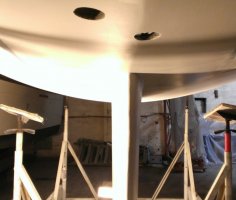Winter '13/'14 Fast Hull Program
A bit of perspective from the center of the country:
- Just like you, the hull was peeled to gelcoat
- with temps anticipated to be brutal (they were), a combination barrier coat of Interlux products was applied: 4 coats of 3000 (good down to a temp of 34 F) and 3 topcoats of 2000, alternating white/grey/white)
- Eventually VC-17 will be rolled on
We are now at the stage of wetsanding the hull, beginning with either 220 or preferably beginning/ending with 320. It will be a time/effort/final result matrix that will guide our process. Interlux recommends not sanding finer then 320 when VC-17 is chosen, it requiring some 'tooth' for adherence.
I'm not familiar with Micron Extra, nor know what type & thickness of roller you applied your 2000 with. We applied with a 1/4" foam roller, paying great attention to thickness, overlaps, sags and seams.
A 1 square foot area was test sanded Saturday, with 400 grit wet sand paper (all that was at the boat, 3M Sandblast flexible pads = the best) and it took 3 minutes to remove the almost imperceptible bumps the foam roller imparted. Haven't extrapolated this to the entire hull, but there's hope.
There are 1-design boats here that use NO antifouling paint, choosing instead to send a diver down (a lot) with their Fast Hull comprised of only Interlux 2000 wetsanded to a glass smooth condition, at least 1000 grit, perhaps beyond. I've run my hand over those surfaces, they were both awesome and disconcerting.
Hope this helps. I'll know more by Wednesday evening.

